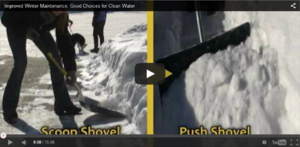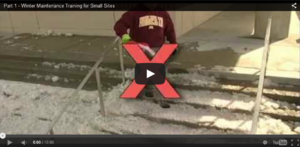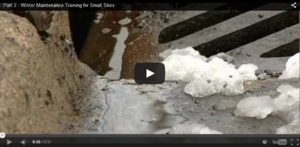
Difference between revisions of "Educational resources for Smart Salting (S2)"
m |
m |
||
| (5 intermediate revisions by the same user not shown) | |||
| Line 1: | Line 1: | ||
| − | |||
| − | |||
| − | |||
| − | |||
| − | |||
Salt that is applied to our roads, parking lots, and sidewalks ends up in our lakes, streams, and wetlands, negatively impacting those water resources. Salt has other negative impacts, such as harming vegetation, including turf, and altering the process of infiltration into soil. | Salt that is applied to our roads, parking lots, and sidewalks ends up in our lakes, streams, and wetlands, negatively impacting those water resources. Salt has other negative impacts, such as harming vegetation, including turf, and altering the process of infiltration into soil. | ||
| Line 33: | Line 28: | ||
*[[Winter Parking Lot and Sidewalk Maintenance Factsheet]] | *[[Winter Parking Lot and Sidewalk Maintenance Factsheet]] | ||
*[[Smart Salting (S2) training information]] | *[[Smart Salting (S2) training information]] | ||
| − | |||
==Links to related material== | ==Links to related material== | ||
| Line 43: | Line 37: | ||
*Overview and impacts of road salt and deicers | *Overview and impacts of road salt and deicers | ||
**[[How salt works and overview of deicing chemicals]] | **[[How salt works and overview of deicing chemicals]] | ||
| − | **[[Environmental impacts of road salt and other de-icing | + | **[[Environmental impacts of road salt and other de-icing chemicals]] |
| − | **[[Other impacts of | + | **[[Other impacts of deicer use]] |
| − | + | *[[Information on costs and economic impacts of road salt]] | |
| − | |||
| − | |||
| − | |||
| − | |||
| − | |||
*Management tools | *Management tools | ||
| − | **[ | + | **[https://www.pca.state.mn.us/sites/default/files/wq-s1-94.pdf Minnesota Statewide Chloride Management Plan] |
| − | **[[ | + | **[[Smart Salting Assessment tool (SSAt)]] |
| − | * | + | **[https://www.pca.state.mn.us/water/statewide-chloride-resources Model Ordinances] |
| − | **[ | + | **[https://www.pca.state.mn.us/water/statewide-chloride-resources Model Snow and Ice Policies] |
| − | **[ | + | *MPCA Smart Salting Training Program |
| − | **[ | + | **[https://www.pca.state.mn.us/water/smart-salting-training Smart Salting Training Program] |
| − | **[ | + | **[https://www.pca.state.mn.us/water/smart-salting-training-calendar/2021-01 Smart Salting Training Calendar] |
| − | *[[Educational resources for Smart Salting (S2)]] | + | **[https://www.pca.state.mn.us/water/salt-applicators Resources for Winter Maintenance Professionals] |
| − | + | **[https://www.pca.state.mn.us/water/statewide-chloride-resources Chloride Reduction Assistance] | |
| − | *[[ | + | *Education Resources |
| − | *[ | + | **[[Educational resources for Smart Salting (S2)]]. For more information on chloride resources, see [https://www.pca.state.mn.us/water/statewide-chloride-resources Statewide chloride resources] |
| − | *[ | + | **[[Success stories: salt reduction and cost saving examples]] |
| + | **[https://www.pca.state.mn.us/water/statewide-chloride-resources Technical reports and Chloride TMDLs] | ||
| + | **[https://www.pca.state.mn.us/water/water-permit-holders-and-chloride Chloride and NPDES Permits] | ||
*[[References for Smart Salting (S2) and road salt winter maintenance]] | *[[References for Smart Salting (S2) and road salt winter maintenance]] | ||
| + | *Chloride and groundwater | ||
| + | **[https://www.mgwa.org/documents/whitepapers/impacts_of_stormwater_infiltration_on_chloride_in_minnesota_groundwater.pdf Impacts of stormwater infiltration on chloride in Minnesota groundwater] - White paper produced for the Minnesota Groundwater Association | ||
| + | **[https://stormwater.pca.state.mn.us/index.php?title=File:Chloride_groundwater_loading_calculator.xlsx Calculator for estimating chloride loading to groundwater] | ||
| + | **[[Guidance for calculator to estimate chloride loading to groundwater from infiltration]] | ||
| − | [[Category: | + | [[Category:Level 2 - Pollutants/Chloride]] |
| + | [[Category:Level 2 - Management/Winter management]] | ||
| + | [[Category:Level 3 - Best management practices/Nonstructural practices/Deicing]] | ||
</noinclude> | </noinclude> | ||
Latest revision as of 19:56, 7 February 2023
Salt that is applied to our roads, parking lots, and sidewalks ends up in our lakes, streams, and wetlands, negatively impacting those water resources. Salt has other negative impacts, such as harming vegetation, including turf, and altering the process of infiltration into soil.
This page provides information on education resources for salt management. Included are links to fact sheets, websites, and videos.
Contents
Residents



- 9 Mile Creek Watershed district fact sheet - this fact sheet offers some background information on effects of salt and a 4-step process for managing ice in residential settings
- MPCA Salt Pollutes postcard - offers tips on ways to reduce salt use. Print and distribute to residents and local businesses.
Building entrances and sidewalks
The MPCA worked with the Mississippi Watershed Management Organization, the University of Minnesota, and Fortin Consulting to produce a 20-minute video that introduces best practices for winter maintenance of small spaces such as sidewalks, entryways, and steps. Guidance includes deicer material selection and application rates. Links to Part 1 and Part 2 of this are shown to the right.
Hire certified contractors
If you hire out snow removal for your property, choose a contractor who is certified by the state in Snow and Ice Control Best Practices or encourage them to become certified. This list of certified practitioners is maintained by MPCA and can be accessed as an File:Road salt training certificate holders.xlsx.
Many local lakes and streams have elevated levels of chloride, a common ingredient in road salt. In some cases, the chloride contamination is high enough to impact or even kill fish and other aquatic life. Winter snow and ice practices have been identified as the primary source of this chloride. Certified contractors have taken a training on how to mitigate the effects of de-icing materials on the environment, without compromising safety or effectiveness.
Voluntary certification in Snow and Ice Control Best Practices from the MPCA is given to individuals who
- attended voluntary training,
- complete and pass the associated test, and
- agree to voluntarily apply best management practices to reduce chloride impacts.
Smart Salting (S2) training program
- Winter Parking Lot and Sidewalk Maintenance Manual
- Winter Parking Lot and Sidewalk Maintenance Factsheet
- Smart Salting (S2) training information
- Snow and Ice Control Material Application (CTAP) - This Circuit Training and Assistance program (CTAP) workshop helps determine the correct chemical and proper application rates based on the weather and pavement temperature for using salt and sand most effectively.
- Clear Roads Winter Maintenance Newsletter - Clear Roads produces a quarterly newsletter that captures the latest research and news on winter maintenance technology and practices within the U.S. and around the world. Each E-newsletter compiles links to recent reports, guidance documents, news articles, and research updates from state DOTs, universities, the Transportation Research Board and the Federal Highway Administration.
Related pages
- Overview and impacts of road salt and deicers
- Information on costs and economic impacts of road salt
- Management tools
- MPCA Smart Salting Training Program
- Education Resources
- Educational resources for Smart Salting (S2). For more information on chloride resources, see Statewide chloride resources
- Success stories: salt reduction and cost saving examples
- Technical reports and Chloride TMDLs
- Chloride and NPDES Permits
- References for Smart Salting (S2) and road salt winter maintenance
- Chloride and groundwater
- Impacts of stormwater infiltration on chloride in Minnesota groundwater - White paper produced for the Minnesota Groundwater Association
- Calculator for estimating chloride loading to groundwater
- Guidance for calculator to estimate chloride loading to groundwater from infiltration
This page was last edited on 7 February 2023, at 19:56.